This website is an archive from 2016
This site was actively maintained from 2006 to 2016. Since then I have kept it online for historical interest, but have made no further updates. Much of the information in these pages is now incorrect or obsolete.
The Soča Valley
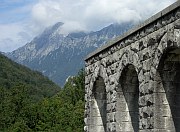
Italian Ossuary, Kobarid

Church of the Assumption
Tucked away in Slovenia's northwest corner is one of the country's most interesting areas. As you head upstream along the turquoise Soča River the scenery becomes ever more grandiose. When you tire of admiring the works of nature you can reflect on the works of man by seeking out reminders of the battles that took place here during World War One. The two main settlements in the upper valley are Kobarid and Bovec.
Kobarid
The town of Kobarid is just a few kilometres from the Italian border, at the point where the Soča emerges from the narrow confines of its upper course and begins to meander through a broader valley. It's a small cluster of flower-bedecked white houses clustered around the elegant belfry of the Church of the Assumption.
If, like me, all your mental images of the First World War involve plains and poppy fields, the Kobarid Museum is an essential stop. For two and a half years the Italian and Austrian/German armies faced each other in the mountains around Kobarid (Caporetto). In addition to the normal hazards of war, they had to deal with the bitterly cold mountain weather and the logistic difficulties of maintaining positions on the crests of mountain ranges. When you see how inaccessible the valley is today, it's hard to grasp the sheer scale of the Soča (Isonzo) front - there were almost a million casualties here. The museum brings the story to life with photographs, charts, and relief displays.
There are a number of marked walking and cycling trains around the town. The 5km Kobarid Historical Trail links some of the main historical and natural sights. It starts at the Italian Ossuary, which is topped by a 17th-century church that was moved here in 1935. A detour from the main trail, signposted to Veliki Rob, takes you to a viewing platform where you can look almost directly down on Kobarid's main square. The main trail leads north past the remains of trenches and observations posts and the ancient archaeological site of Tonočov Grad. After crossing the river via a high footbridge you reach the Kozjak Waterfall. The path returns to Kobarid crossing the arched Napoleon Bridge.
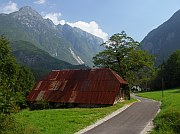
Near Bovec
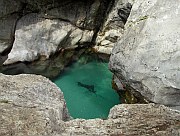
Zmuklica, near Bovec
Bovec
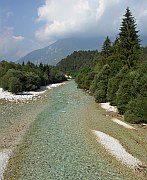
Soča River near Bovec
It's a good thing Bovec is surrounded by dramatic scenery, as the town itself is rather characterless and less appealing than Kobarid. Every building seems to house an adventure sports agency or a restaurant full of large groups discussing the day's activities. It also seems to attract a lot of motorcyclists - I would have preferred to enjoy the scenery without the constant drone of Harley engines. Bovec is definitely the place to come if you are interested in rafting, kayaking, mountaineering, paragliding, or a variety of other organised activities.
Even if you just want to walk, there are plenty of trails of various lengths and difficulties in the surrounding area, many of them making use of bouncing footbridges to cross rivers. You may catch a glimpse of the Boka Waterfall from the Kobarid-Bovec road, but you can have a closer look by following a trail southwest from Bovec. Another trail leads west to Zmuklica, just off the Bovec-Trenta road. At this point the river passes through a narrow ravine of smooth near-white rocks - a lovely spot to relax and watch the kayakers struggling with the currents. Several trails lead northwest to the fortress at Kluže. The higher trails alternate between forest and scree; from the latter there are views across to Svinjak, the pyramidal mountain that dominates Bovec. The rock strata, some of them in an almost vertical position, are clearly visible. The fortress, which was built by the Austrians during the First World War, is in good condition and contains a museum. A short distance uphill through the forest you can find the ruins of another fortress, Fort Hermann.
The Vršič Pass
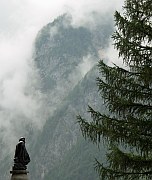
Kugy Monument, Vršič Pass
From Bovec a road leads north over the Vršič Pass to Kranjska Gora. The first part of the route follows the Soča River to Trenta, where there is an information centre for Triglav National Park. The marked Soča Trail allows you to visit the sites of interest in this part of the valley without having to walk on the road. One of these sites is the Alpinum Julijana, a botanical garden displaying both Alpine and Mediterranean flora. I found it a little disappointing, perhaps autumn is not the best time to visit. Just upstream from the garden a short detour leads to the Mlinarica Chute, where a tributary river emerges from a narrow gorge to join the Soča. Continuing northwards you will reach the monument to Julius Kugy, a climber who helped to draw attention to the beauty of this part of the alps. Near the statue a track heads northwest to the source of the Soča (Izvir Soče), where the stream emerges from a cave and immediately hurls itself over a waterfall. The last part of the trail is quite tricky if the rocks are wet after recent rain.
After Trenta the serious climbing starts; 50 hairpin bends later you arrive at the summit of the Vršič Pass (1611) where you can enjoy wonderful views. Or not, as the case may be: all I could see was thick cloud. If you have both suitable equipment and suitable weather, a number of high-level hikes start from the Tičarjev Dom mountain hut at the pass. The road continues down another 50 or so switchbacks to Kranjska Gora.
Practicalities
It is quite possible to enjoy a visit to the Soča Valley without a car, but it requires a bit more planning than other parts of Slovenia. Several daily buses run along the valley from Bovec to Kobarid (40 mins) and Tolmin (1.5 hours), from where you can continue by bus to Ljubljana or the train station at Most na Soči. At least one daily bus goes all the way from Bovec to Ljubljana (4 hours).
From November to April the road over the Vršič Pass is closed to all traffic. Bus services over the pass from Bovec to Kranjska Gora via Trenta vary depending on the season. Very roughly, in July and August you should have no trouble doing the trip by bus on any day, while in May-June and September-October you may find a bus running on Saturdays and Sundays. At these times the schedules make it easier to do a day trip from Kranjska Gora to Trenta or Bovec than vice versa.
Good walking/tourist maps of the area are available locally and in Ljubljana bookshops. The 1:25000 "Bovec z okolico" map is particularly useful - it shows six numbered walking trails and five bike trails around Bovec, and points of natural and historical interest are clearly marked.
More photos of the Soča Valley in my Slovenia Galleries